Collaborative Learning
Collaborative learning is an umbrella term that encompasses various educational approaches that involve joint intellectual efforts by learners with minimal supervision. It entails students working in groups that have mutual interests such as the search for knowledge, creating meanings, designing a product, or seeking solutions to common problems affecting them. The activities of collaborative learning vary widely. However, researchers attest that most of them revolve around solving learning difficulties, exploration, and application of their course materials.
Andragogy
Malcolm Knowles defines the term Andragogy as the art and science of helping adults learn. The term was first coined by the German Alexandar Kapps in 1833 as he described Plato’s educational theory. Andragogy is the art and science of teaching adults, whereas pedagogy is the art and science of teaching children. A distinguishing factor between Andragogy and Pedagogy is that the former is learner-centered whilst the latter is teacher-centered. While adult learners determine their interest and choice of material to study, children learn what the teachers deem necessary for them.
The Six Malcolm Principles of Andragogy
Malcolm put forward six principles of adult learners that teachers need to take into account. Firstly, Malcolm describes adults as autonomous and self-directed. Adults have a tendency to directing their learning. They actively involve themselves in learning as they work to their particular interests and personal goals. Adults like taking leadership roles. Secondly, adults bring their life experiences and knowledge to learning experiences, including work-related activities, family roles, and previous educational experiences. Adults are goal-oriented. Their learning processes align with their set goals that ought to be achieved through the learning activities. Teachers should capitalize on adults’ goals in a bid to deliver a valuable learning experience for adult learners. Furthermore, Malcolm describes adults as relevancy-oriented. They view learning as reasonable as they obtain something out of it.
The andragogy theory needs to marry the practical experiences of adult learners. Adults are practical. They like to apply their knowledge in real-life situations. Lastly, Malcolm posits that adults need to be respected for they bring life experiences to the learning environment. Thus, they need to be treated as equals as they voice their opinions and in directing their learning processes.
Theoretical Foundations: Evolvement of Learning Theories
Behaviorism
Behaviorism is a theory of animal and human learning that centrally focuses on objectively observable behaviors and discounts mental activities. According to the behaviorist theorists, learning is merely the acquisition of new behavior. They posit that learning as a universal process is characterized by two types of conditioning that shape the behavioral pattern outcome. Firstly, classic conditioning features natural reflex responsiveness to a stimulus. For instance, Pavlov observes that dogs salivate upon seeing food. The premise here is certain stimuli induce different specific behavioral responses by animals and people. Secondly, behavioral or operant conditioning happens when a response to a certain stimuli is reinforced.
The ideology of this conditioning is based on the fact that it is a simple feedback system that, if a reward or reinforcement follows the response to a stimulus, the response more likely in the future. This theory impacts learning in that it is simple to comprehend as it relies on observable behavior and describes numerous universal laws of behavior.
Cognitivist Theory
In the late 1950s, the learning theory shifted from the use of behavioral models to the cognitive-based learning models. Educators stressed complex processes, including thinking problem solving, language, concept formation, and information processing. This shift from the behavioral orientation is accomplished by emphasizing the promotion of student performance through the manipulation of the stimulus material to a cognitive orientation that is based on the development of mental processing.
The learning process through cognitive theories is based on the acquisition of knowledge and internal mental structures. Learning is associated with the discrete changes between the states of knowledge rather than with changes in the probability of stimuli response. It focuses on the conceptualization of the students’ learning processes whilst addressing the issues on how the information is received, organized, stored, and retrieved by the mind. Knowledge acquisition is defined as a mental activity that involves internal coding and structuring by the student who is actively involved in the learning process.
Constructivism Theory
Constructivism is a philosophy of learning founded on the assumption of reflection on people’s experiences. People construct their understanding of the world. They generate their rules and mental models that they use to make sense of their experiences. In this regard, learning can be seen as a process of adjusting the mental models to accommodate new experiences. This theory has several guiding principles. Firstly, learning implies searching meaning that must start with the issues around which the learners actively try to construct sense. Secondly, meaning requires an understanding of wholes and parts. The parts must be understood in the context of wholes. As a result, the learning process centers on primary concepts but not secluded facts. Teachers must understand the mental models that students use to build perceptions of the world and the assumptions on which they base those models. Additionally, the purpose of learning is for an individual to construct their perceived meaning.
Constructivism impacts learning in several ways based on curriculum, instruction, and assessment. It calls for the dismissal of a conventional curriculum. It promotes the utilization of the curricula customized to the learners’ prior knowledge and emphasizes hands-on problem-solving. Educators seek to make connections between facts and foster new understanding in students. Instructors mold their teaching strategies to analyze, interpret, and predict information. Constructivism eliminates grading and standardization testing and instead makes assessment part of the learning process to involve students in playing larger roles in judging their progress.
Collaborative Learning Theories
Socio-Cultural Theory
Vygotsky’s sociocultural theory of human learning is an approach that regards learning as a social process. The theoretical framework Vygotsky is based on the theme of social interaction that plays a fundamental role in the development of cognition. In this theory, learning is deemed to occur at two basic levels that involve interaction between people and then integrating everything learned into the learner’s mental structure. He posits that learning occurs firstly at the social level (inter-psychological) and individual level (intra-psychological). Another aspect of the Vygotsky’s theory is the notion that the potential for cognitive development is limited to a zone of proximal development (ZPD). This zone is the area of research that the learner cognitively prepares and requires help and social interaction to develop fully. Collaborative learning, scaffolding, modeling, and discourse strategies support the intellectual knowledge and skills of students besides enabling intentional learning.
Social Constructivist Theory
Social constructivism is an approach that views the learner as a complex and multidimensional individual with unique needs and backgrounds. The theory acknowledges and integrates the complexity and uniqueness of the learners by encouraging and rewarding them in the course of the learning process. Social constructivism and culturalism encourage the learners to make their version of truth leveraged by their background, culture, or the entrenched world view. Jean Piaget argues that without the learner integrating with other members of the same cultural background, it is impossible to acquire the social meaning of important symbols and learning how to utilize them practically. From the social constructivist theory perspective, it is important to take account of the learners’ social-cultural background throughout the learning process. This background helps in shaping the knowledge and truth that the student discovers, attains, and creates in the learning process.
Andragogy in Practice
Communities of Practice (COPs)
The Communities of Practice (CoPs) refer to a recent coinage that implies various group formations by people who engage in collaborative learning in a shared domain of human endeavors. Such affiliations can comprise a tribe learning to survive, a band of artists looking for new forms of expression, or a group of engineers working on identical problems. The CoPs entail groups of people who share a passion for something common as they learn how to do it better through regular interactions.
Structural Elements of Communities of Practice
The CoPs have three distinctive structural elements that differentiate them from a community. Domain: a community of practice has an identity defined by a shared domain of interest. Therefore, membership implies a commitment to the domain; hence, it is an indicator of a shared competence that distinguishes the members from other people. The members of the community of practice value their collective competence besides learning from each other. Very few people outside this group can acknowledge their expertise. Secondly, the community members indulge in joint activities and discussions the help them share the information in the pursuit of common interest. A perfect example of a community of practice is a group of painters who meet and learn and invent new painting methods. The community of practice involves practitioners who develop a shared repertoire of resources, including stories, tools, and ways of addressing common problems in a short of shared practice.
Seven Principles of cultivating the Communities of Practice
The objective of the community of practice design is to evoke aliveness, internal direction, energy, and character. It requires a different set of design principles. There are seven design principles that focus on evoking aliveness in a community of practice that include the design for evolution, open dialogue between the inside and outside perspectives, inviting different levels of participation, developing both public and private community spaces, focusing on value, combining familiarity and excitement, and creating a rhythm for the community.
Five Stages of COPs Development
Just like living things, communities of practice go through a natural life cycle of birth, growth, and death. These stages are considered as indicative rather than descriptive. This indication is done with the use of a jagged line, as depicted in figure 1.0.
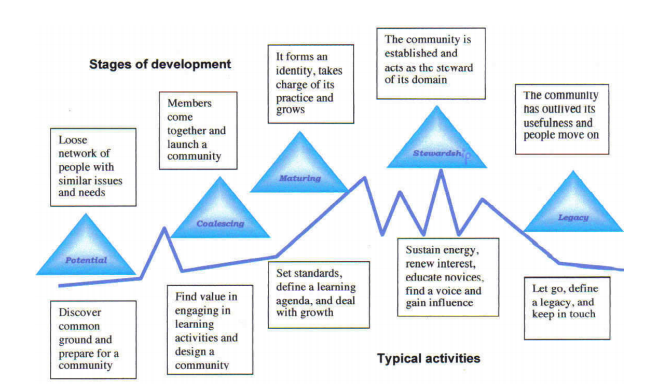
Stage 1: Potential
The potential stage is characterized by a loose network of people who interact occasionally guided by a situation of interest. At this stage, people establish basic elements of a community and the potential of it becoming one loom. People engage in private conversations and begin viewing their relationship from a new perspective.
Stage 2: Coalescing
A community is born but remains in infancy. At this stage, people have had their hopes brought out by the discovery of the potential of their community and commitment to sustain its development. However, the value of the community has to become a reality in their lives. For instance, members of a community get only convinced when they begin seeing their problems solved in unison. It is a fragile stage in community development that is crucial to understand the needs of the transitional stage as a spike of interest. As the community tries to find a rhythm, the reality of the work that the development requires arises. However, after the initial interest, a sharp decline in people’s energy is possible.
Stage 3: Maturing
A communal identity develops at this stage. After coalescing, people acknowledge the fact that they have some meaningful things in common to share. In addition, members set standards to make their relationship survive and endure. The community’s activities intensify and become more focused and systematic about developing standards for recurring common problems.
Stage 4: Stewardship
In this phase, the group has established its identity as a community. It is the beginning of an active life. The communities of practice begin to adapt to change upon reaching maturity. They start becoming responsive to the environment and even shaping and influencing it by focusing on their problems and commencing new projects. New relationships and sub-groups emerge as the communities become more complex sets of activities of common interest. As the group admits fresh members and address new emerging issues, they redirect its focus to meet the needs of the new membership.
As the communities of practice reach maturity, they recognize the need for tapping various sources of inspiration, such as leadership and other organizational contexts. At this point, the community begins to reason strategically about the knowledge they have acquired and building on it. Stewardship stage sees communities of practice, often turning their attention to their relationships with organizations and other groups. After successfully building their practice, they yearn to have a voice that reflects the authority they have attained with respect to their domain.
Stage 5: Legacy
Communities of practice must make lastly meet their end and create a chance for a new life. Their domain becomes irrelevant as members focus on other interests and activities. At this stage, some organizations might merge with others to form entirely different entities seeking new interests. Alternatively, some groups become too complex to make sense maintaining the same mega-group. The original community splits into smaller distinct groups to address more specific interests. Communities seek to leave a legacy at this stage. Some communities can decide to outlive their business.
Value and Application of the Communities of Practice to the Organizational Learning
Knowledge Management
The communities of practice have several beneficial elements of ton organizations. The most prominent of all include: Ensuring access to relevant knowledge, including both explicit knowledges found in institutions and tacit knowledge inherent in individual members. The communities of practice ensure a high quality of knowledge is shared and managed for the best interest of the entire organization. Organizations have access to experienced persons in respect to the domain of the communities. Moreover, organizations find a common basis for jointly initiated and implemented projects. In fact, researchers argue that communities of practice contribute positively to improving the quality and sustainability of organizational projects and programs. They increase the potential for innovation, thus, reducing risk factors and finally leveraging organizational change.
The communities of practice, increase networking, research outputs in learning, and teaching. They facilitate the transfer of knowledge between young adults and older adults in an organizational context. They nurture talent and provide the best opportunities for problem-solving besides developing new capabilities.
Role of Leadership in CoPs
Leaders play several key roles in the communities of practice. For instance, they identify the potential CoPs that will add value to the organization’s performance and strategic capabilities. They also create an appropriate culture in the CoPs that aligns itself with the corporate society by providing the necessary organizational systems such as group structures & technology-based platforms for knowledge sharing and management, facilitating social associations and learning among the members of the CoPs. Furthermore, the leaders are also charged with monitoring and assessing value creation that translates into improved organizational performance.
Instructional Design for Adults
There are several instructional design models for adult learners, including the ADDIE Instructional design Model, Front-End Analysis (FEA), and Outcome-Based Instructional Design.
The ADDIE Instructional Design Model
Instructional design entails the organized approach to the analysis, design, development, implementation, and evaluation of learning materials and activities. They seek to develop learner-centered instructional design as opposed to teacher-centric approaches for effective learning to take place. The ADDIE Design Model presents five phases that sometimes overlap and can be interrelated but provide a dynamic and supple framework for developing effective and efficient instruction. The ADDIE Model instructional design process provides a platform where the results of the formative evaluation for each phase can lead the instructional designer back to any preceding phase. The ADDIE model is shown in figure 1.1 below.
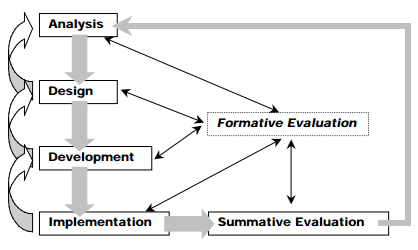
The analysis phase is the basis for all other phases of instructional design, here, the instructional designer states the problem, identifies its source, and determines possible solutions. This stage entails certain research practices, including needs analysis, job analysis, and task analysis. The design phase entails the use of the results from the abovementioned phase to draw a plan and strategy for developing instruction. Common elements here may comprise writing target population description and conducting a learning analysis, among others. The development phase builds on both the two above phases. Its role is to generate lesson plans and lesson materials.
The implementation phase refers to the real deal that involves delivery of the planned instruction that can take place in a classroom, lab or computer-based platform. This phase focuses on efficient and effective instructional delivery. Evaluation phase assesses the level of effectiveness of the delivered instruction. It is recommended that evaluation remains continuous throughout the instructional design process such as within or between the several phases.
Outcome-based Instructional Design: Backward Design Three Phases
The outcome-based instructional design is a three-phase model involving identification, determination, and planning of learning outcomes. This model is based on the premise that the design model development is for non-traditional setting but rather the online collaborative learning arena. Figure 1.2 illustrates the three phase design model.
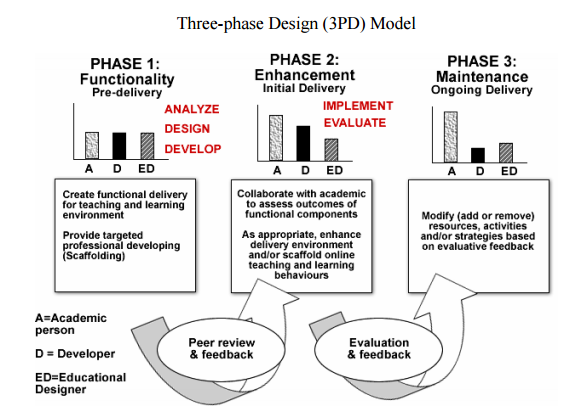
Bloom’s Taxonomies (Cognitive Domain)
Cognitive learning is exhibited through knowledge recall and the intellectual skills that include comprehending, organizing ideas, synthesizing data, applying knowledge, choosing among alternatives in problem-solving and evaluating ideas and/or actions. Knowledge is defined as the ability to recall previously learned material that can involve a wide range of material including specific figures, and facts with a view of bringing out the suitable information.
Comprehension is the ability to grasp the perceived meaning of learning material. This activity may entail conversion of material into different forms like word formations, or estimating future trends with a basis of observed data or predicting effects of a phenomenon. Application implies the position of the learner to utilize the learned material in new concrete situations. It may involve applying things such as concepts, principles, laws or theories. Analysis refers to the ability to break down material into its fragmented parts. For instance, it can involve identification of parts, analysis of relationships, and recognition of organizational principles that guide employees conduct and behavior.
Synthesis refers to the ability of the learner to assemble different fragmented parts together to form a new whole. This process can involve the production of a new and unique communication such as speech or theme, or a set of abstract operations. This process calls for creative behavior for the learners. Instructors emphasize mostly on the formulation of new patterns of structures and integration for excellent learning outcomes. Evaluation concerns itself with the ability to make appropriate judgments about the value of the learning material such as a novel, a piece of research or a report. The judgments should be based on definite criteria to provide evidence-based and justified judgment. The criteria can be internally or externally determined. This stage is the highest level of learning outcomes for the cognitive hierarchy because it takes care of the requirements of all other categories. Figure 1.3 shows the Bloom’s Taxonomies.
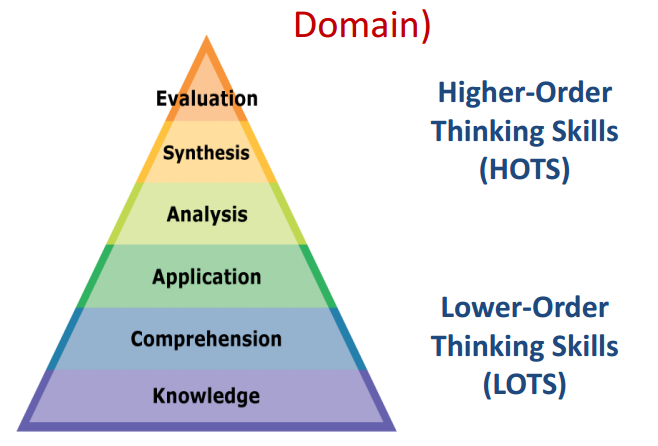
The Whole-Part-Whole (WPW) Learning Model
The WPW model is an approach that shows the existence of a natural whole-part-whole rhythm to learning. Through the first whole, the model introduces new content to the learners’ mind thereby forming an organizational perspective that is needed to accommodate the forthcoming ideas into their collection of knowledge efficiently. The part aspect of the whole-part-whole learning model involves the supporting know-how and constituent behaviors established in the classical style of instruction.
The last whole features a collection of achieved performance criteria that is linked together by the teacher. The WPW learning experience provides students with complete understanding of the instructional material at various levels performance. It also allows for higher cognitive development to the improvement and invention levels. The WPW can be utilized from program design through to the real-time instructional adjustment during a class presentation. Figure 1.4 represents the WPW Instructional design model.
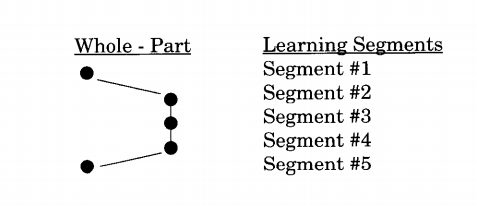
Collaborative Learning versus Cooperative Learning
How to make the Collaborative Learning Successful
The collaborative learning process can be made more fruitful through encouraging positive interdependence through interpersonal and group skills, processing, and accountability. A growing group of literature suggests that students achieve higher critical thinking skills through collaborative learning. In small groups, students learn to work together toward a common focus. The students feel responsible for each other’s understanding and encourage each other to grasp the idea of common interest. It has been proven that the success of one student in a group influences the success of the rest as there is interdependence amongst the members. Instructors can achieve better results by encouraging students to learn these attributes in the small groups to boost knowledge transmission amongst the members.
Computer Supported Collaborative Learning (CSCL)
CSCL is the learning of adults with the help of computers. It is often conflated with e-learning, the organization of instruction across computer networks. CSL emphasizes collaboration among students to elude isolated reactions to online posted content. It is also concerned with face-face (F2F) collaboration through computer simulations of scientific models and/or shared interactive representation. Collaboration focuses on construction and the exploration of the representation or models.
Adult Learning in Organizational Contexts
The Learning Organization
A learning organization changes the behaviors and mindsets of people following some experience. The ability of organizations to abandon dysfunctional behaviors and embrace change that places them in a competitive position. It is the organization that established the capability to learn, adapt, and change continuously through the practice of knowledge management.
Characteristics of Learning Organizations
During the learning process, employees in an organization influence each other and their ideas co-evolve, grow, and change to suit the context of others. Upon reaching the complete change, it will turn and influence what happens in the next stage. As organizational environment change and expose the organization to different situations, it will tend to co-evolve to adapt to these changes to thrive. It can be seen as the concept of adaptability associated with the learning organizations. Another characteristic of learning organizations is an open team-based organizational design that empowers employees. They encourage a concept of self-organization whereby employees do not need a manager to control their actions, rather the groups come together to explore new ideas. Additionally, organizations portray extensive and open information sharing amongst members.
Leadership in learning organizations provides a shared vision of the organization’s future, support, and encouragement. They have a resilient culture of shared values, trust, openness, and a sense of community. Sustainability of organizations can be attributed to multiple and intricate networks of relationships coupled with shared communication and other forms of rigorous feedback and interdependence.
Knowledge Management
Knowledge management (KM) can be defined as the planning, organization, motivation, and controlling of people, processes and systems in an organizational context to ensure that its knowledge-related assets are enhanced and effectually utilized. Knowledge management process involves knowledge acquisition, creation, refinement, storage, transfer, sharing, and utilization. The organization’s knowledge management function establishes methodologies and systems to operate these processes and instill motivation in employees besides supporting them. The key goals of KM are to leverage and improve organization’s knowledge assets with of effectuating better knowledge practices, improved organizational behavior, better decisions, and improved overall performance.
There are two key processes of knowledge management namely knowledge transfer and creation. The former is attained through information sharing that can take place through sharing stories. It leads the organization to identify the best practices that favor overall performance. On the other hand, knowledge creation is achieved through collaborative inquiry by the small groups in the organization. Knowledge acquired through inquiry results in the creation of new and informed solutions to organizational problems affecting employees. Knowledge management in the human resource development has two facets including training and development, and organizational development. Staff training entails a cost effective way to develop workforce and organizational capacity. Leadership and good management are vital factors to organizational growth and sustainability.
The key function of human resource development is to aid alignment of company goals and objectives with the employee knowledge-base to achieve optimal performance of the organization. To achieve optimal performance, HRD involves two forms of organization learning namely life-long learning and life-wide learning that mainly seek to develop the human resource that is based on knowledge economy rather than a production economy.
Researchers believe that when the staff is equipped with sufficient knowledge, problem solving becomes an easy task because the employees can easily work them out in their groups without necessarily requiring managerial mediation. This state of affairs is a basic concern for HRD concepts of knowledge management as it aids to manage people in evolving and changing organizational contexts. In the modern world, individuals and organizations have developed adaptations that match the development of a learning society that promotes knowledge economies.